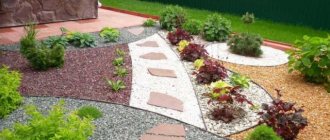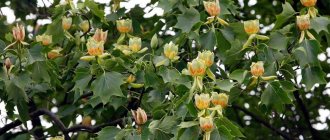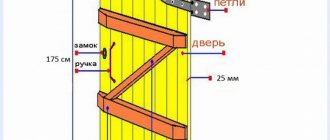Project of a plot with flower beds
Let's take a closer look today at how to make a beautiful flower bed with your own hands in the country house or in the courtyard of a private house. Below will be posted photos of the most beautiful and original, but at the same time simple flower beds, most of which can be made, you won’t believe it, from scrap materials: stones, bottles (both plastic and glass), tires and tyres.
We will touch in detail on creating flower beds made of brick and wood (from boards), design ideas and ways to create borders and fences for flowers near the house. All of the listed flower beds are also suitable for kindergartens. Basically, these are very interesting models for both landscape design professionals and novice summer residents. See step-by-step guides in photo galleries, as well as a selection at the end of the article.
High flower bed made of concrete blocks
This is what a flowerbed looks like, which you can make yourself.
To do this, first of all, we outline the contours of the future flower bed on the ground and dig a ditch.
We install the concrete blocks evenly and carefully, checking from time to time for correct installation.
We concrete around the installed blocks and level them well.
We wait for the concrete to dry completely and fill in the prepared soil.
The high flower bed is ready, you can plant suitable plants. Due to the fact that it is tall, the flowerbed will be a clearly visible, bright decoration of the site.
Slough show: the story of one flowerbed
How the flower garden in the city has changed - through the eyes of a high-rise building tenant
Introduction
Based on your wishes, you can create the flower garden of your dreams with your own hands.
Parterre (geometric) flower beds have a symmetrical shape and are usually located in front of the entrance to the building. Open-plan flower beds provide more room for imagination compared to ground floors. They can be designed taking into account the unevenness of the landscape, and installed in a quiet area of the garden, near the pool.
Stone bricks are an excellent solution for zoning
The background for a flower bed, as a rule, is decorative shrubs with attractive foliage colors or small beautifully flowering trees. When creating flower beds, various types of decoration are used: solitaires, rutaria, alpine slides, arches, borders, etc.
Tapeworm is a solitary growing plant that looks spectacular at any time of the year, stands out against the general background of the flowerbed, forming a bright spot. The purpose of a tapeworm is to attract attention. The life of the entire flower garden revolves around the tapeworm.
Dwarf spruce will perfectly cope with the role of tapeworm
For single plantings, use light-loving plants; they can be either annuals or perennials. Among annuals, decorative sunflower, burgundy amaranth, castor bean are good as tapeworms, among biennials - mallow, foxglove, among perennials - queen of shade astilbe, daylily, tree peony.
Laying a brick flowerbed with your own hands
A brick flowerbed near the house is a good solution for landscaping the yard . It’s not difficult to make one yourself, especially one as small as in the photo. Although, of course, you need to have some skills. If you make a higher masonry, then everything must be done correctly so that it does not fall apart. But even without the skills, you can try laying out masonry for a flower bed using these instructions.
Before you start work
Choose bricks that tolerate moisture well; ordinary ones are not suitable for the long term. For decoration, facing bricks with a beautiful texture are best suited. For a small flower bed like in the photo you will need about 50 bricks and 30 kg of mortar. If you want to make more, say six rows, one and a half meters long and half a meter wide, then one hundred bricks and 80 kg should be enough. solution.
Making masonry
Make markings, drive in pegs with stretched twine. Prepare the trench.
Step 1 Lay out the bricks without mortar at even intervals. This will tell you if you need to insert a short brick at the end of the masonry. If necessary, you can increase the space between the bricks, in case there is just a little missing, so as not to insert a very small piece of brick. Mark the location of the first and last brick.
Step 2 Install the first bricks. Mix a small portion of the solution. Install the first two bricks at the beginning and end of the future masonry. Check the level in both directions, tapping the handle of the spatula to make adjustments.
Step 3 Place the first row. Grab a trowel full of mortar and apply it on a row of three bricks across the entire width, the layer thickness is approximately two centimeters. Smooth the solution from the front side up.
Step 4 Align the corners and check them with a plumb line. Having completed the first row, begin laying the second one overlapping the first. Constantly check the horizontal surface of the masonry with a level and the thickness of the seams.
Step 5 Complete each row completely. Use twine to keep the line flush with the front side. If the required piece is missing, you can cut it with a grinder; if not, then file it to the required size and then chop it off with a hammer on a wooden plank.
Step 6 Check the masonry again with a level. Continuously tap with a hammer to adjust the level. As you go, remove excess mortar from the trowel. To form a nice seam, you can remove the excess with a piece of garden hose.
Do not miss such a moment as waterproofing the flower bed . After the masonry has dried, about a day in dry weather, treat the internal walls with bitumen emulsion, then the bricks will not absorb moisture from the ground.
It is also necessary to provide drainage holes in the masonry ; for this, do not fill the three vertical gaps in the first row of bricks with mortar. At the base of the future flower bed, remove five centimeters of soil and fill it with a layer of fine gravel. Lay the turf that you removed to cover the gravel on top. To allow the soil to sag, let the flowerbed stand like this for about ten days, after which you can fill in the fertile layer of soil and plant flowers or other plants.
Read more about how to make flower beds from bricks here
Budget flower beds for summer residents
An inexpensive and quick way to create a flower garden at your dacha with your own hands is to use scrap materials and unnecessary items. Any stones, bricks, pebbles are suitable for decorating flowerbed borders.
They are left natural or painted in bright colors.
A budget option is to use saw cuts or stumps to create a flower bed of annual flowers with a small root system.
This is how you can decorate flower beds with tulips, pansies, and petunias. To make such a flower garden with your own hands, you need:
- Choose a stump or cut that is not rotten or damaged by insects.
- Use a saw or chisel to make a recess in it, leaving 5 cm around the circle untouched.
- Coat the wood with an antiseptic compound.
- Make drainage in the form of drilled inclined holes on the walls. Place a layer of gravel on the bottom.
- Fill the structure with soil and plant the selected plants.
Video instruction:
Other wooden products are also suitable for decorating a flower garden - pegs, logs, sawdust, branches. For example, you can weave baskets from willow branches and use them as containers for flowers.
In much the same way as from a stump, you can create flower beds from various old things - carts, boats, cars, cages, TVs, barrels, any damaged furniture.
If the area of the summer cottage is small, then small flower beds can be made from a watering can, suitcase, old bags, bottles, glass or plastic plates.
A painted car tire makes a bright flower bed, and boxes and pallets make the basis for creating a multi-tiered flower garden.
Beautiful combinations of flower beds
Beautiful flower beds are obtained by using interesting combinations in the composition not only of plant varieties, but also:
- by color - gradient, contrast, similar shades;
- in form - smooth chaotic lines, strict geometric shapes, ornaments;
- additional elements.
You can successfully play with a variety of objects, making them the central element of the flower garden, its base or border. These can be the already described budget options or, for example, a bridge, a garden fountain, a bench around which flowers are planted.
Volumetric flower beds always look beautiful. To create them, taller flowers are planted in the center, then lower ones, and ground cover varieties are planted at the edges.
Alyssum
Such a flowerbed can be made in an old tire, barrel, or box. By analogy with size, you can use another plant parameter - color: plant dark blue flowers in the center, then blue, and white at the edges.
Primrose and irises in a flowerbed
An interesting option is a stone garden . This is the name of a flower garden that is grown on stones. They are fixed with lime mortar or laid out on a designated area randomly or in accordance with a pre-planned pattern.
Plants, edible greens, and herbs are planted in the spaces between the stones. Often such compositions are complemented by shrubs and trees, especially if a rather large area is allocated for the garden.
Flowerbeds under a tree
How to make a flower bed under a tree
If there are trees on your site, a flower garden around the trunk will be a good solution to save space. Let's look at how to make a flower bed under a tree, so to speak, a classic version of a round flower garden. . The pictures below clearly depict the entire process. The photo, of course, is from a bourgeois website, but they know how to draw beautifully, even film a cartoon.
First, in the area around the tree where you are going to plant a flowerbed, you need to remove the turf. Then it can be used for other purposes; there will probably be a place on the site where grass does not grow well.
Buy at the store or make your own metal strip with spikes to mark the edge of the flowerbed with a border. In principle, you can use anything for temporary fencing, but a strip is more convenient.
Fill the prepared area with soil to a height of eight centimeters so that the top roots do not protrude from the ground.
Level the top layer of soil and place a layer of sawdust on it so that the ground is completely covered.
You can first plant flowers and then add sawdust, but practice shows that it is better to first plant sawdust and then plant plants.
We plant flowers, which ones and how to plant them depends on what you have chosen. This issue needs to be studied in advance; there are many nuances here. Not all flowers can take root under a tree, depending on what tree it is under.
Making a border. There are many options here too. At the bottom of the article, in the gallery, you can see what types of flower beds there are and what they are covered with. The easiest way is, if you find paving stones, and you already have a temporary fence installed, it won’t be difficult to simply cover it beautifully with paving stones or, say, brick.
The flowers have been planted, all that remains is to organize regular watering, at least for the first month, and then, depend on the weather.
When the flowers grow, you can show off to your neighbors.
Floral arrays
Unlike the group, the massif occupies a large area that can extend for tens of square kilometers. Arrays can be plain or variegated.
Suitable for single-color arrays:
- lavender
- phlox
- poppies
- tulips
Floral array of tulips of different varieties
It is not easy to create a high-quality massive planting. It should be harmonious, the colors should complement each other. For example, an array of blue pansies, which are located in the foreground, gradually turning into more saturated blue irises.
Contrasting array without further ado
Creation of contrasting arrays is allowed.
The following options are possible:
- pink phlox and white delphiniums
- delicate white daffodils and bright red peonies
- fiery swimsuit and purple cockerels
And a few more flower beds
A selection of beauty in your eyes
Border
An important element is the border surrounding the flowerbed. The border gives the flower garden completeness. You can also make a “living” border from low, brightly flowering annual plants, such as marigolds or low-growing begonias.
The border neatly outlines the flowerbed, giving it completeness
When selecting planting material, you need to proceed from the following considerations:
1 the plant must be dense and bushy
2all plants must be the same height
3maintain its attractiveness after flowering
4easy to tolerate trimming
5be resistant to temperature changes
Petunia flower border
Options for borders
Annual plants:
- lobelia
- Chernobrivtsy
- low growing carnation
- fuchsia
- cineraria
- brachycoma
Perennials:
- catchment area
- host
- day-lily
- Heuchera
Assortment of plants for an attractive garden
Annuals:
- Chernobrivtsy
- petunia
- brachycoma
A flower bed of ground cover plants along the garden path
Biennials:
- pansies
- daisies
- rose stem (mallow)
It is not easy to create work from perennial plants.
Varietal composition for perennial ridges:
- low growing aster
- tree peony
- delphinium
- day-lily
- Heuchera
- small petal
Watering
The best time to water is early morning
In summer, perennial flowers need to be watered often and in large quantities. If they lack moisture, they will bloom poorly and will not have the desired aesthetic effect.
Do not water the plants on the leaves, pour water directly under the roots, this way you will avoid the spread of powdery mildew.
Do not forget to remove faded branches, inflorescences, and leaves that have lost their attractiveness. Try to keep your flowerbed decorative for as long as possible.
climbing plants
In flower beds, climbing plants are located on supports, usually in the center
- Lianas and climbing plants are always welcome guests in the garden. They are distinguished by rapid growth of shoots, carved foliage, numerous flowers, and sometimes attractive fruits.
- To achieve maximum beauty, you need to use supports and create an appropriate background.
- Use combinations of contrasting colors, for example, clematis can be planted in dark purple and white.
- The supports should be comfortable and easy to use.
- Climbing plants can decorate lamp posts and unsightly buildings.
Mixborders
Combined mixborder along the fence
Mixborders are multi-row flower beds of ornamental plants . The plants are selected so that when some fade, others immediately bloom, and the mixborder remains attractive throughout the season.
A flower bed that is attractive in the off-season is the pinnacle of a florist's skill
Mixborders are often placed along buildings, on lawns, and near swimming pools in the form of bright color spots. The edges of the mixborder are limited to lawn grass or laid out with tiles, stones, and stump cuts.
Perennial cereal grasses look beautiful in mixborders
The selection of plants should be such that the flower garden will be a decoration throughout the entire summer season. For mixborders, annuals and biennials are used, but the main place, of course, belongs to perennial plants.
Use pebbles to fill empty spaces between plants
The background for a mixborder can be:
- pampas grass bush
- tree peony
- barberry
- dogwood
- small beautiful flowering tree
Combined mixborder along the fence
Car tires – a classic of country fashion
Old car tires, which don’t seem to be needed, but would be a shame to throw away, can do a good job in landscaping. With a certain amount of imagination, you can use them to create original flower beds that will be the envy of your neighbors.
Car tires are good because they can be placed anywhere on the site, in different orders. You can paint them either one or different colors, hang the tires on trees or put one on top of the other, play with them in a different way. But before you start forming a flower bed, wash the dirt off the tires, degrease them with acetone and only then start painting.
Layout
Perennials are grouped by growth, flowering time, color, and type of leaves. Choose plants that are not particularly labor-intensive to care for.
Moderately labor-intensive perennials include:
- astilbe
- aster
- geranium
- primrose
- brachycoma
- cloves
- sedum
Foxglove requires virtually no care
Among the unpretentious ones the most popular are:
- monarda
- stock-rose
- digitalis
- lily of the valley
- digitalis
- lavender
- phlox
- lovage
Features of care
Whatever design option is chosen, some effort will have to be made to ensure that the flower bed growing upward looks good. To do this you will have to:
- carefully observe the watering regime , otherwise the enclosed space will provoke the death of the plant;
- organize drip irrigation , it will reduce moisture deficiency and facilitate daily care;
- when the first signs of various diseases appear, treat flowers and herbs with pesticides ;
- in the cold season, bring vertical flower beds into a heated room , or use annual plants .
Even a beginner can handle such work, so growing vertical flower beds is not difficult.
Convenient drip irrigation system Source rmnt.ru
Laying a rock garden
If the plants you plan to plant like acidic soil, add peat chips, and if they prefer alkaline soil types, then you need to lim the soil with lime.
It is not recommended to use manure and large amounts of nitrogen fertilizers, as the plants will begin to vegetate wildly, this will give them an unusual appearance, they will stretch out, become unstable to diseases and lower temperatures.
In addition, manure can contain a huge amount of weed seeds, and as you know, weeds are the worst enemies of flower beds.
Early flowering crocuses take pride of place on alpine hills
In the first 2 - 3 years you can not apply fertilizers at all; in subsequent years you need to add a little superphosphate.
The range of plants used for alpine slides is very wide
Cereals:
- ground cover plants
- all kinds of bells (Carpathian bellflower, Campanula angustifolia)
- Heuchera
- looked younger
- bloodroot
- saxifrage
- savory
- lavender
From early flowering plants you can plant:
- crocuses
- saffron
- decorative bow
- hazel grouse
- hyacinths
Single growing ferns will look beautiful.
Among the shrubs there are many attractive low plants that are suitable for decorating an alpine slide:
- barberry
- heather
- rhododendron
- low growing spirea
- euonymus
- boxwood
Sedum and young - a standard set for a top-end rock garden
Coniferous plants look beautiful: decorative low-growing Christmas trees, pines, yew, juniper.
Primroses
One of the first flowers after the snow melts
- Bulbous flowers evoke tender and tremulous feelings; these are the first flowers after winter that we have been waiting for for so long.
- They look touching against the backdrop of the remnants of snow; they should be placed closer to paths and garden paths so that you can admire them.
- Make sure your garden looks decorative from early spring to late autumn. Yes, it's difficult, but possible.
- Take into account all the features, remember that early flowering plants are usually short, so they will need a good background to highlight their beauty.
- Use boxwood bushes, low-growing thuja or juniper as a background.
Formation of compositions
When arranging flower beds, assume that the main colors are red, blue and yellow.
Flower beds with plants of the same color, but in different shades, look beautiful
Green, purple, and blue flowers look beautiful in the foreground. Cool shades are perceived better up close, because the further they are located, the less impression they will make and will merge with the surrounding landscape.
Also, when creating flower beds, use white color, plants with silver foliage, they look very impressive and, as it were, soften the impression of contrasting neighbors. When creating flower beds, the emotional side is very important, how the plant is perceived by us, people.
The aesthetic side is one of the most important in creating flower beds
Look at the peonies, how luxurious they are, large, majestic, covered in drops of dew, almost the size of a saucer, heavy with the abundance of petals. Forget-me-nots and viola will look beautiful next to peonies.
It is necessary to plant these crops in the most accessible places in your garden; peonies have few competitors that would look so decorative. Projects of two-story houses Z500 https://z500.com.ua/doma/poisk/dvuhetazhnye-doma.html on the official website https://z500.com.ua
Peony bushes need space and green lawns
In early spring, the burgundy sprouts of these flowers look attractive and elegant. After flowering, the bush keeps its shape for a long time and even in autumn pleases with its yellow, red and brown colors, standing out against the background of the lawn and shrubs.











